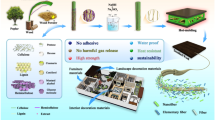Abstract
Aluminate-based coupling agent was added as a compatibilizer to make the chemical modification of wood powder. The mechanical properties and morphology of wood powder/polypropylene composites were studied. The results showed that the compatibilizer can increase the impact strength of the wood/polypropylene composites, but it has a slightly negative effect on the tensile and flexural strength. For dynamic mechanical properties and Differential Scanning Calorimetry, Aluminate-based coupling agent can slightly increase the storage modulus and loss modulus, and decrease the melt point and the Calorie of Melt. Scanning electron microscopy showed that Aluminate-based coupling agent had a stronger affinity between the wood and polypropylene surfaces. These results suggested that Aluminate-based coupling agent may play a useful role in improving wood powder/polypropylene composites properties.
Similar content being viewed by others
References
Berger, M.J. and Stark, N.M. 1997. Investigations of species effects in an injection-molding grade, wood-filled polypropylene [C]. The Fourth International Conference on Woodfiber-plastic Composites, p 19–25.
Flex, J.M. and Gatenholm, P. 1991. The nature of adhesion in composites of modifies cellulose fibers and polypropylene [J]. J. Appl. Poly. Sci.,42, 609–620.
Kazayawoko, M., Balatinecz, J.J. and Matuana, L.M. 1999. Surface modification and adhesion mechanisms in woodfiber-polypropylene composites [J]. J. Mater. Sci.,34(24): 6189–6199.
Fujii, T., Lee, S.J., Kuroda, N. and Suzuki, Y. 2001. Conductive function of intervessel pits through a growth ring boundary of Machilus thunbergii [J]. IAWA J.,22: 1–14.
Hill, C.A.S. and Khalil, H.P.S.A. 2000. Effect of fiber treatment on mechanical properties of coir or oil palm fiber reinforced polyester composites [J]. J. Appl. Poly. Sci.,78: 1685–1697.
Maldas, D., Kokta, B.V. and Daneault, C. 1989a. Influence of coupling agents and treatments on the mechanical properties of cellulose fiber-polystyrene composites [J]. J. Appl. Polym. Sci.,37: 751–775.
Matuana, L.M., Balatinecz, J.J., Sodhi, R.N.S. and Park, C.B. 2001. Surface characterization of esterified cellulosic fibers by XPS and FTIR spectroscopy [J]. Wood Sci and Technol,35(3): 191–201.
Mekenzie, A.W. and Yuritta, J.P. 1979. Wood fibre reinforced polymers [J]. Appita,32(6): 460–465.
Myers, G.E., Chahyadi, I.S., Coberly, C.A. and Ermer, D.S. 1991. Wood flour/polypropylene composites: Influence of maleated polypropylene and process and composition variables on mechanical properties [J]. Intern. J. Poly. Mater.,15: 21–44.
Oksman, K. and Lindberg, H. 1995. Interaction between wood and synthetic polymers [J]. Holzforschung,49: 249–205.
Oksman, K. 1996. Improved interaction between wood and synthetic polymers in wood/polymer composites [J]. Wood Sci. Technol.,30: 197–205.
Oksman, K. and Clemons, C. 1998. Mechanical properties and morphology of impact modified polypropylene-wood flour composites [J]. J. Appl. Polym. Sci.,67: 1503–1513.
Raj, R.G., Kokta, B.V., Maldas, D. and Daneault, C. 1989. Use of wood fibers in thermoplastics. VII. The effect of coupling agents in polyethylene-wood fiber composites [J]. J. Appl. Polym. Sci.,37: 1089–1103.
Stark, N.M., Berger, M.J. 1997. Effect of particle size on properties of wood-flour reinforced polypropylene composites [C]. The Fourth International Conference on Woodfiber-plastic Composites, p 134–143.
Takatani, M., Itoh, H., Ohsugi, S., Kitayama, T., Saegusa, M., Kawai, S. and Okamoto, T. 2000. Effect of lignocellulosic material on the properties of thermoplastic polymer/wood composites [J]. Holzforschung,54: 197–200.
Wu, J.D., Chan, C.M., Kim, J. and Mai, Y.W. 2000. Effect of fiber pretreatment condition on the interfacial strength and mechanical properties of wood fiber/PP composites [J]. J. Appl. Poly. Sci.,76: 1000–1010.
Author information
Authors and Affiliations
Corresponding author
Additional information
Foundation item: This study was supported by Introduce Foreign Advanced Technology Project (2001-1).
Biography: Qin Te-fu (1954-), Male, professor, Research Institute of Wood Industry, Chinese Academy of Forestry, Beijing 100091, P. R. China.
Responsible editor: Song Funan
Rights and permissions
About this article
Cite this article
Te-fu, Q., Luo-hua, H. & Gai-yun, L. Effect of chemical modification on the properties of wood/polypropylene composites. Journal of Forestry Research 16, 241–244 (2005). https://doi.org/10.1007/BF02856824
Received:
Accepted:
Issue Date:
DOI: https://doi.org/10.1007/BF02856824




